Lingering Leonids, the Evening Moon Meets Mars while Wading through Water Stars, then dips into Earth’s Penumbra!
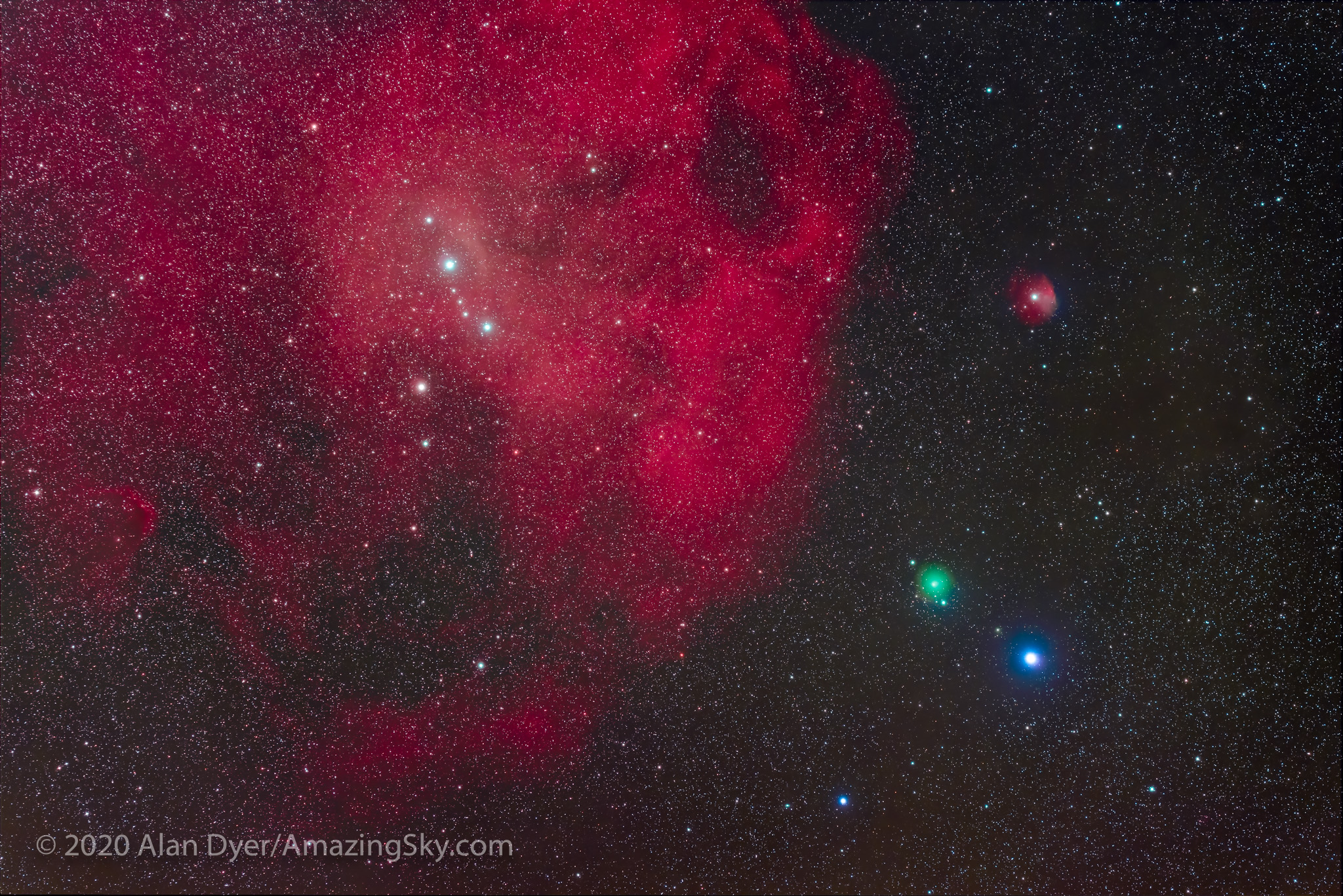
This spectacular image by “AmazingSky” guy Alan Dyer of Calgary, Alberta, taken on November 15-16, 2020, captured the fuzzy green blob of comet C/2020 M3 (ATLAS) as it passed the bright, bluish star Bellatrix in Orion (the Hunter). The red nebulosity at top left is glowing Hydrogen gas surrounding Meissa, aka Lambda Orionis, the head star of Orion. Alan combined non-filtered exposures with filtered exposures designed to enhance the nebula. The area of sky shown spans about a palm’s width, top-to-bottom. His Flickr gallery of gorgeous images is at https://www.flickr.com/photos/amazingsky/with/50611065022/
Hello, Moon Lovers!
Here are your Astronomy Skylights for the week of November 22nd, 2020 by Chris Vaughan. Feel free to pass this along to your friends and send me your comments, questions, and suggested topics. You can also follow me on Twitter as @astrogeoguy! Unless otherwise noted, all times are expressed in Eastern Time. To subscribe to these emails please click this MailChimp link.
I can bring my Digital Starlab portable inflatable planetarium to your school or other daytime or evening event, or teach a session online. Contact me through AstroGeo.ca, and we’ll tour the Universe, or the Earth’s interior, together!
The moon will brighten this week as it waxes to full before dawn on Monday morning, November 30, when a weak, penumbral lunar eclipse will occur for observers in the western hemisphere. Starting hours earlier, on the previous Sunday evening, the moon will caress Taurus’ face. The moon will visit Mars at mid-week, too. Although dimming now, Mars will continue to be a splendid all-night target – with much dimmer Uranus and Neptune sharing the sky with it. Jupiter and Saturn will only be observable during early evening – but they’re getting closer together! Read on for your Skylights!
Meteor Showers
The Leonids Meteor Shower, which is derived from bits of material dropped by periodic Comet 55P/Tempel-Tuttle, will taper off until December 3. There are a few other minor showers underway, too – so you can expect to see a few meteors per hour this week, especially after midnight. My last Insider’s Guide to the Galaxy stream was all about meteors and meteorites. It’s on YouTube here.
The Moon
After yesterday’s (Saturday) first quarter phase, the moon will be ramping up in brightness this week as it waxes in illuminated phase while it increases its angular separation from the sun. Unless you happen to live in Antarctica, this week will be a fine time to view the lunar terrain in binoculars and telescopes – all at a convenient time. That’s because our natural satellite will rise during the afternoon and then remain visible until after midnight every night. Last week, I wrote about the way slanted sunlight enhances the waxing moon’s topography here.
The moon will wade through the water constellations this week – but its brightness will hide their modest stars. On Sunday (tonight) and Monday, the moon will shine among the stars of Aquarius (the Water-Bearer). On Monday evening, the pole-to-pole terminator that divides the lit and dark hemispheres of the waxing gibbous moon, will fall just to the left (or lunar west) of Rupes Recta, also known as the Lunar Straight Wall. The rupes, Latin for “cliff”, is a north-south aligned fault scarp that extends for 110 km across the southeastern part of Mare Nubium, which sits in the lower third of the moon’s Earth-facing hemisphere. The wall, which is very easy to see in good binoculars and backyard telescopes, is most prominent a day or two after first quarter, and also the days before last quarter. For reference, the very bright crater Tycho is located due south of the Straight Wall.
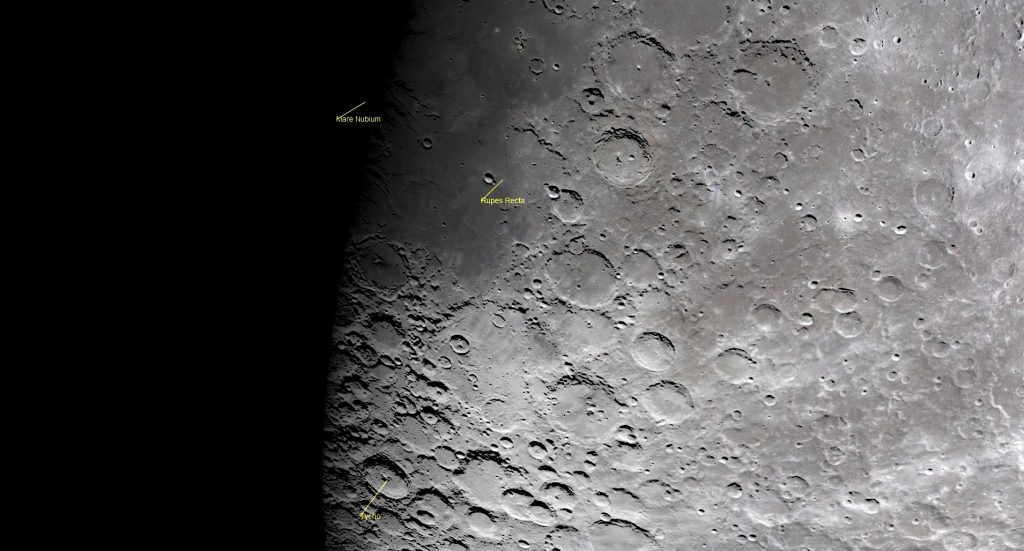
From Tuesday through early Friday, the moon will travel along the crooked boundary between Pisces (the Fishes) and Cetus (the Whale). In the southeastern sky after dusk on Wednesday, the waxing gibbous moon will be located a generous fist diameter to the right (or 5 degrees to the celestial southwest) of reddish Mars. The moon and Mars will cross the sky together until well after midnight. By then, the diurnal rotation of the sky, and the moon’s eastward orbital motion, will shift the moon to Mars’ left, in the western sky.
On Thursday night, the terminator will fall to the left (or lunar west) of Sinus Iridum, the Bay of Rainbows. The circular, 249 km diameter feature is a large impact crater that was flooded by the same basalts that filled the much larger Mare Imbrium to its right (lunar east) – forming a rounded, handle-shape on the western edge of that mare. You can see it with sharp eyes – and easily in binoculars and backyard telescopes. The “Golden Handle” is produced when slanted sunlight brightly illuminates the eastern side of the prominent, curved Montes Jura mountain range that surrounds the bay on the top and left (north and west), and by a pair of protruding promontories named Heraclides and Laplace to the bottom and top, respectively. Sinus Iridum is almost craterless, but hosts a set of northeast-oriented dorsae or “wrinkle ridges” that are revealed under magnification at this phase.
On Friday and Saturday night, the nearly full moon will cross through Aries (the Ram). Although the moon will sit only a few finger widths below the planet Uranus in Aries on Friday night, the bright moonlight will make that relatively dim and distant planet all but invisible.
Between next Sunday evening and Monday morning, the moon will reach its full moon phase while it is passing just above (to the celestial north of) Taurus (the Bull). The bright orange-tinted star Aldebaran, which serves as the bull’s southern eye, will sit below the moon in evening. Binoculars might reveal the large open star cluster, known as the Hyades, that forms the rest of Taurus’ triangular face – if you keep the bright moon hidden just above your field of view. By dawn, the rotation of the sky will lift Aldebaran and the Hyades’ stars to the moon’s left.
Since it’s opposite the sun on this day of the lunar month, the full moon rises at sunset and sets at sunrise. If you look closely at the moon on Saturday evening, you should be able to tell that it’s not quite full, yet. A thin sliver on its upper right edge will still be dark – making it look less than perfectly round. In the Americas, the moon will be precisely full before dawn – at 4:44 am EST, or 9:44 Greenwich Mean Time. When the moon rises at sunset on Monday evening, that missing sliver will have jumped to moon’s opposite, left-hand edge – because the moon’s angle from the sun has changed from less to 180 degrees, to slightly more than 180 degrees.
The November Full Moon, traditionally known as the Beaver Moon or Frost Moon, always shines in or near the stars of Taurus and Aries. Full moons occurring during the winter months climb as high in the sky around midnight as does the summer noonday sun, and cast similar looking shadows from the trees and structures in your backyard.
Indigenous groups have their own names for the full moons, which lit the way of the hunter or traveler at night before modern conveniences like flashlights. The Anishinaabe people of the Great Lakes region call this one Mnidoons Giizisoonhg, the “Little Spirit Moon”, a time of healing. The Cree Nation of central Canada calls it Kaskatinowipisim, the “Freeze Up Moon”, when the lakes and rivers start to freeze. The Haudenosaunee Confederacy (Iroquois / Mohawk) of Eastern North America call it Kentenha, the Time of Poverty Moon. With this full moon occurring on the boundary between modern calendar months, which were not employed by indigenous groups, it might be more appropriate to use their December moon names. But I’ll wait until next month to share those.
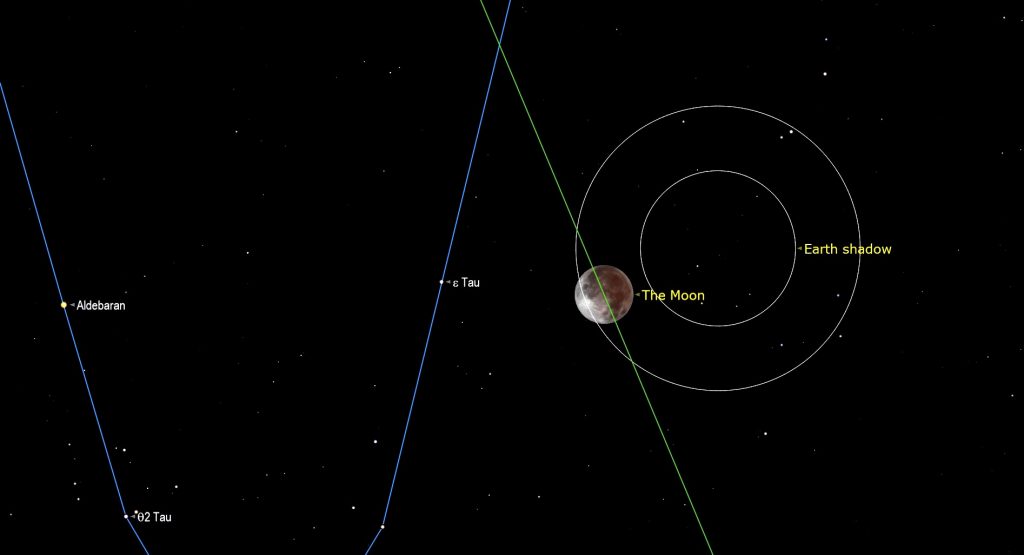
The moon’s orbital motion while it’s full will carry it into Earth’s circular outer shadow, producing a penumbral lunar eclipse that will be visible in its entirety across most of North and Central America, and northern Asia. The moon will first contact the Earth’s outer shadow at 2:32 am EST, or 07:32 GMT. At greatest eclipse at 4:44 am EST, or 09:44 GMT, approximately 83% of the moon’s disk will be within the Earth’s southern penumbral shadow. At that time, the moon will be sitting rather low in the western sky for observers in the Eastern Time zone.
Penumbral eclipses aren’t very obvious, at all – but they are perfectly safe to look at without eye protection. The subtle darkening of the moon’s right-hand (northern) limb will be noticeable only within about 30 minutes of greatest eclipse. The eclipse will end at 6:53 am EST, or 11:53 GMT. In the Eastern Time zone, the moon will be close to setting at that time. For observers in more westerly time zones, the eclipsed moon will sit higher in the western sky. South America and northern Europe will only see the early stages of the eclipse, while Australia, Southeast Asia, China, and parts of Russia will only see the latter stages. I won’t be getting out of bed for this one – but do let me know if you see it!
The Planets
For one final week, it’s possible to see all seven classical planets in the sky between dusk and dawn – and Earth under your feet for the eighth. Pluto is up there, too – near Jupiter – but it’s much too dim to see by beginner skywatchers.
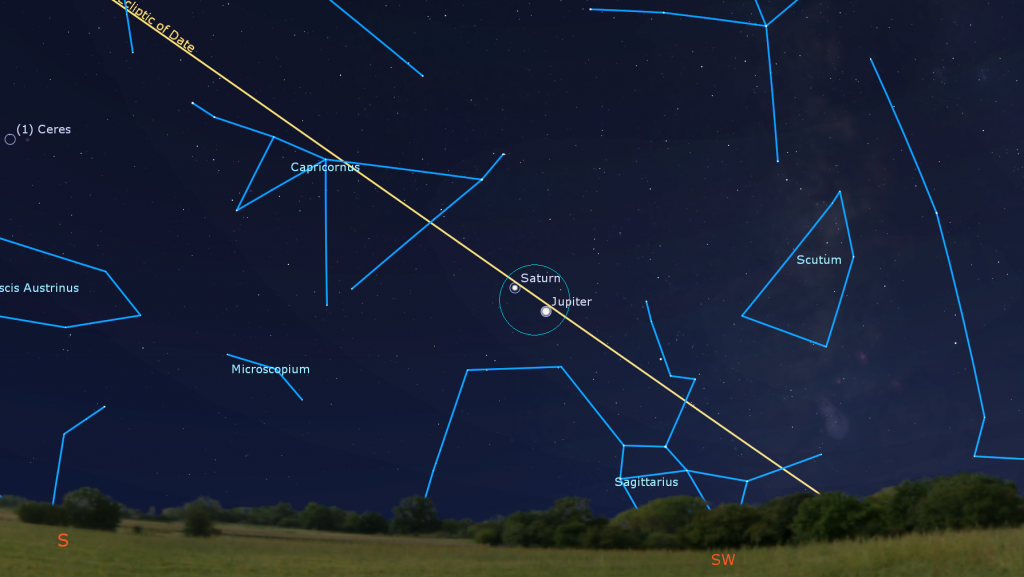
As the sky begins to darken, look for very bright, white Jupiter shining in the lower part of the southwestern sky. Yellowish Saturn is smaller in size and farther from us than Jupiter. That makes it about 12 times dimmer than Jupiter – so it won’t be visible until the sky is darker. Look for the yellowish ringed planet sitting a few finger widths to Jupiter’s upper left (or 3 degrees to the celestial east). Being closer to the sun, Jupiter is moving eastward faster than Saturn. It’ll catch up and then pass Saturn on December 21, when they’ll look like a single, bright ”Solstice Star”! In the meantime, watch their separation decrease every week.
Our season of clear telescope views of those two planets is just about over. Long before 7 pm in your local time zone, they will be getting very low in the southwestern sky, and shining through a much thicker blanket of Earth’s atmosphere. You might even see them twinkle a little bit before they set! Good binoculars should still show you the four large Jupiter moons that Galileo Galilei discovered in January, 1610. Named Io, Europa, Ganymede, and Callisto, they dance around the planet from night to night – although one or more can be hidden by Jupiter at any given time.
Saturn is a spectacular sight. Any backyard telescope will show you Saturn’s rings. See if you can see the Cassini Division. It’s the narrow, dark gap that separates Saturn’s main inner ring from its outer one. Your telescope should also reveal several of Saturn’s moons – especially its largest, brightest moon, Titan! Because Saturn’s axis of rotation is tipped about 27° from vertical (a bit more than Earth’s axis), we are seeing the top surface of its rings – and its moons can arrange themselves above, below, or to either side of the planet. During evening this week, Titan will migrate counter-clockwise around Saturn, moving from the upper left of Saturn tonight (Sunday) to the lower right of the planet next Sunday. (Remember that your telescope might flip the view around.)

Back in June and July, when they were moving retrograde westward, Jupiter and Saturn passed close to a globular star cluster named Messier 75 (or M75). Now that the two planets have resumed normal eastward motion, they are going to pass that cluster again. This week, in binoculars or telescopes, look for a faint fuzzy patch located about two finger widths to the upper left (or 2 degrees to the celestial southeast) of Saturn. Try to see the globular cluster at about 6 pm local time – when it’s higher, and the sky has darkened fully. Unfortunately, the bright moon will make seeing the cluster harder this week.
Mars is still a wonderful evening and late-night target! This week, the bright, reddish-tinted planet will already be shining in the lower part of the southeastern sky after dusk. Mars will climb to its highest point – and best viewing position, a bit more than half-way up the southern sky – at about 9 pm local time. Then it will set in the west before sunrise. The planet is now moving slowly eastward toward the V-shaped stars of Pisces (the Fishes) on its left. Mars will be rapidly fading in brightness and size from this point forward.
Viewed in a telescope this week, Mars will display the dark Mare Cimmerium and Sinus Sabaeus regions around its equator, and the bright, adjacent Memonia and Elysium regions. Look for a small bright dot near the planet’s edge. That’s the south polar cap! A good Mars mapping tool is here. Note that the tool flips the planet to match a typical telescope. You’ll need to know the Universal Time (UT) that corresponds to the local time when you are viewing the planet. In the Eastern Time Zone, 02:00 UT equals 9 pm EST.
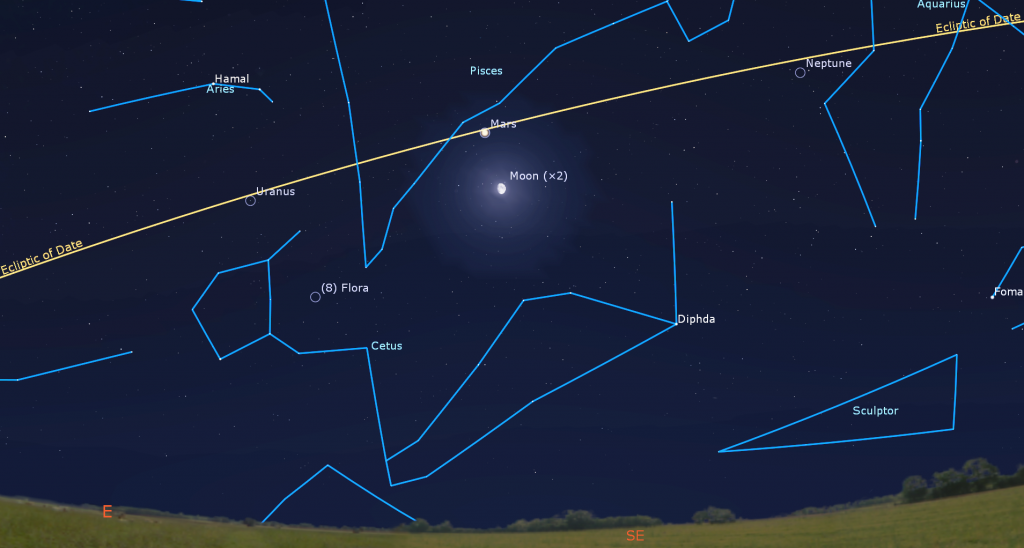
Blue-green Uranus is among the stars of southern Aries (the Ram) – a fist’s diameter below and between Aries’ two brightest stars Hamal and Sheratan. For context, that region of the sky is two fist diameters to the left (or 22° to the celestial east) of Mars. At magnitude 5.7, Uranus is usually within reach of backyard telescopes, binoculars, and even sharp, unaided eyes – but this week’s nearby bright moon will spoil the fun.
Deep blue Neptune is located about 2.7 fist diameters to the right (celestial west) of Mars – among the stars of northeastern Aquarius (the Water-Bearer). The dim, magnitude 7.86 planet is sitting about two finger widths to the left (or 2 degrees to the celestial east) of the medium-bright star Phi Aquarii or φ Aqr. This week, dim and distant planet will already be in the lower southeastern sky after dusk. Then it will climb higher until just 7:30 pm local time, when you’ll get your clearest view of it while it’s almost halfway up the southern sky. The bright moon will hinder your view of Neptune even more than Uranus! On Saturday, November 28, Neptune will complete a retrograde loop that has been carrying it westward through the stars of Aquarius since late June, and will resume its regular eastward motion.
Venus has been gleaming in the eastern pre-dawn sky for some time now. It will rise at about 4:45 am local time this week, and then remain visible in the eastern sky until sunrise while it is carried higher by the rotation of the Earth. Viewed in a backyard telescope, Venus will show a slightly less than round shape. This week, the planet will be traveling down (or celestial eastward) – leaving the stars of Virgo (the Maiden) and entering next-door Libra (the Scales). Venus is shifting towards the sun – but the later sunrises at this time of year will allow it to shine in a dark, pre-dawn sky until early December!

For Northern Hemisphere observers, Mercury should continue to be visible in the eastern pre-dawn sky. Look for the swiftly-moving planet shining very low in the east-southeastern sky, below and a bit to the left of Venus, at around 6:45 am in your local time zone. Mercury will be harder to see as this week rolls on, because Mercury is now descending sunward. In a telescope Mercury will have a similar shape to Venus. Be sure to put binoculars and telescopes away well before the sun rises!
Public Astro-Themed Events
Every Monday evening, York University’s Allan I. Carswell Observatory runs an online star party – broadcasting views from four telescopes/cameras, answering viewer questions, and taking requests! Details are here. Their in-person Wednesday night viewing has been converted to online via the observatory Youtube channel, where they offer free online viewing through their rooftop telescopes, including their new 1-metre telescope! Details are here.
On Wednesday evening, November 25 at 7:30 pm EDT, the RASC Toronto Centre will live stream their monthly Speakers Night meeting. This month will feature Daniel Siegel, Assistant Professor, Perimeter Institute for Theoretical Physics, Waterloo. His talk, entitled How to Make Gold (Astrophysically Speaking), will look at how gravitational wave detectors monitor the most violent events in the Universe. Everyone is invited to watch the presentation live on the RASC Toronto Centre YouTube channel. Details are here. The RASC Toronto Centre has an archive of their past meetings and guest lectures on their YouTube Channel here.
On Thursday, November 26 at 7 pm, Space Place Canada will broadcast a free presentation entitled Canada and the Final Frontier: Looking Back with Randy Attwood. Randy will highlight how Canada will contribute to space exploration. More details and the registration link are here.
On Friday evening, November 27 at 8 pm EDT, the RASC Mississauga Centre will live stream a presentation by Dr Michael Daly, Lassonde School of Engineering at York University. His talk, entitled Canada at Asteroid (101955) Bennu, will discuss the OSIRIS-Rex spacecraft sample return mission to Bennu. Details and the Zoom link are here.
My free, family-friendly Insider’s Guide to the Galaxy webcasts with Jenna Hinds of RASC National will return on Tuesday, December 1. You can find more details, and the schedule of future sessions, here and here.
Keep looking up, and enjoy the sky when you do. I love questions and requests. Send me some!